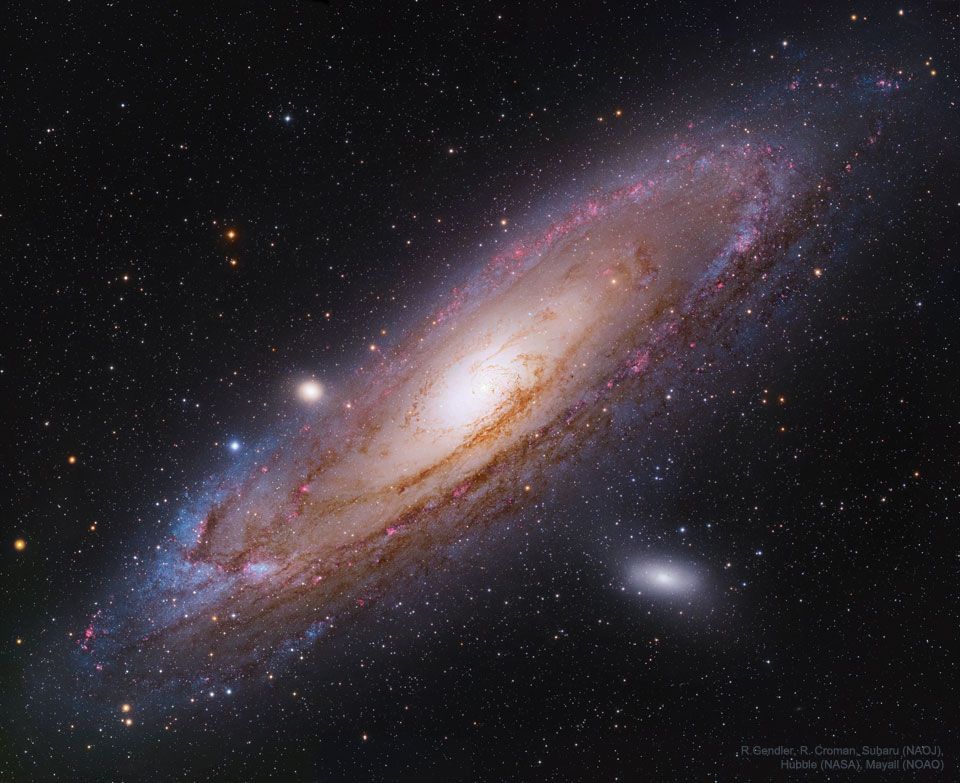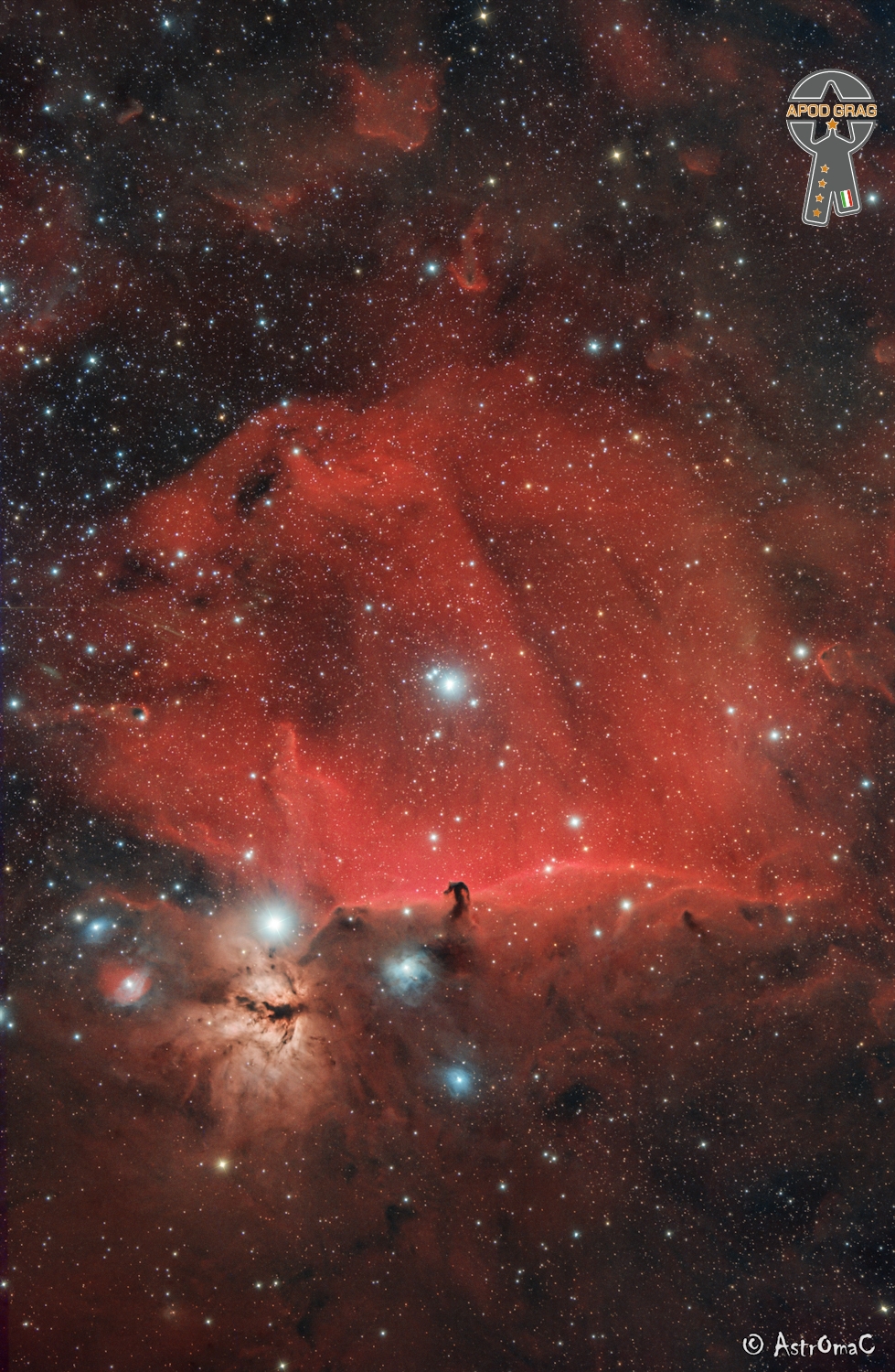Blog
The most distant object easily visible to the unaided eye is M31, the great Andromeda Galaxy. Even at some two and a half million light-years distant, this immense spiral galaxy — spanning over 200,000 light years — is visible, although as a faint, nebulous cloud in the constellation Andromeda. In contrast, a bright yellow nucleus, dark winding dust lanes, and expansive spiral arms dotted with blue star clusters and red nebulae, are recorded in this stunning telescopic image which combines data from orbiting Hubble with ground-based images from Subaru and Mayall. In only about 5 billion years, the Andromeda galaxy may be even easier to see — as it will likely span the entire night sky — just before it merges with our Milky Way Galaxy.

Janis Joplin (January 19, 1943 – October 4, 1970) was an American singer-songwriter who sang rock, soul, and blues music. One of the most successful and widely known rock stars of her era, she was noted for her powerful mezzo-soprano vocals and “electric” stage presence.
In 1967, Joplin rose to fame following an appearance at Monterey Pop Festival, where she was the lead singer of the then little-known San Francisco psychedelic rock band Big Brother and the Holding Company. After releasing two albums with the band, she left Big Brother to continue as a solo artist with her own backing groups, first the Kozmic Blues Band and then the Full Tilt Boogie Band. She appeared at the Woodstock festival and on the Festival Express train tour. Five singles by Joplin reached the Billboard Hot 100, including a cover of the Kris Kristofferson song “Me and Bobby McGee“, which reached number one in March 1971. Her most popular songs include her cover versions of “Piece of My Heart“, “Cry Baby“, “Down on Me“, “Ball and Chain“, and “Summertime“; and her original song “Mercedes Benz“, her final recording.
Joplin died of a heroin overdose in 1970, at the age of 27, after releasing three albums (two with Big Brother and the Holding Company and one solo album). A second solo album, Pearl, was released in January 1971, just over three months after her death. It reached number one on the Billboardcharts. She was posthumously inducted into the Rock and Roll Hall of Fame in 1995. Rolling Stone ranked Joplin number 46 on its 2004 list of the 100 Greatest Artists of All Time and number 28 on its 2008 list of 100 Greatest Singers of All Time. She remains one of the top-selling musicians in the United States, with Recording Industry Association of America certifications of 18.5 million albums sold.
Janis Joplin was born in Port Arthur, Texas, on January 19, 1943, to Dorothy Bonita East (1913–1998), a registrar at a business college, and her husband, Seth Ward Joplin (1910–1987), an engineer at Texaco. She had two younger siblings, Michael and Laura. The family attended First Christian Church of Port Arthur, a church belonging to the Christian Church (Disciples of Christ) denomination.
more...Willie Lee “Big Eyes” Smith (January 19, 1936 – September 16, 2011) was an American electric blues vocalist, harmonica player, and drummer. He was best known for several stints with the Muddy Waters band beginning in the early 1960s.
Born in Helena, Arkansas, Smith learned to play harmonica at age 17 after moving to Chicago, Illinois. His influences included listening to 78’s and the KFFA King Biscuit radio show, some of which were broadcast from Helena’s Miller Theater, where he saw guitar player Joe Willie Wilkins, and harmonica player Sonny Boy Williamson II. On a Chicago visit in 1953 his mother took him to hear Muddy Waters at the Zanzibar club, where Henry Strong’s harp playing inspired him to learn that instrument. In 1956, at the age of eighteen he formed a trio. He led the band on harp, Bobby Lee Burns played guitar and Clifton James was the drummer. As “Little Willie” Smith he played in the Rocket Four, led by blues guitarist Arthur “Big Boy” Spires, and made recordings that were later reissued on the Delmark label. In 1955 Smith played harmonica on Bo Diddley‘s recording of the Willie Dixon song “Diddy Wah Diddy” for the Checker label. Drummers were in more demand than harp players so Smith switched to drums and starting playing with Muddy Waters band. Smith recorded with Muddy on the 1960 album Muddy Waters Sings Big Bill Broonzy, a tribute to Big Bill Broonzy.
more...Horace Parlan (January 19, 1931 – February 23, 2017) was an American pianist and composer known for working in the hard bop and post-bop styles of jazz. In addition to his work as a bandleader Parlan was known for his contributions to the Charles Mingus recordings Mingus Ah Um and Blues & Roots.
He was born in Pittsburgh, Pennsylvania, United States. In his birth year, Parlan was stricken with polio, resulting in the partial crippling of his right hand. The handicap contributed to his development of a particularly “pungent” left-hand chord voicing style, while comping with highly rhythmic phrases with the right.
Between 1952 and 1957, he worked in Washington D.C. with Sonny Stitt, then spent two years with Mingus’ Jazz Workshop. In 1973, Parlan moved to Copenhagen, Denmark. He later settled in the small village of Rude in southern Zealand. In 1974, he completed a State Department tour of Africa with Hal Singer. His later work, such as a series of duos with the tenor saxophonist Archie Shepp included the album Goin’ Home (1977), steeped in gospel music.
Parlan received the 2000 Ben Webster Prize awarded by the Ben Webster Foundation.
more...Augustus Owsley Stanley III (January 19, 1935 – March 12, 2011) was an American audio engineer and clandestine chemist. He was a key figure in the San Francisco Bay Area hippie movement during the 1960s and played a pivotal role in the decade’s counterculture. Under the professional name Bear, he was the soundman for the rock band the Grateful Dead, whom he met when Ken Kesey invited them to an Acid Test party. As their sound engineer, Stanley frequently recorded live tapes behind his mixing board and developed their Wall of Sound sound system, one of the largest mobile public address systems ever constructed. Stanley also helped Robert Thomas design the band’s trademark skull logo.
Stanley was the first known private individual to manufacture mass quantities of LSD. By his own account, between 1965 and 1967, Stanley produced at least 500 grams of LSD, amounting to a little more than five million doses.
He died in a car accident in Australia (where he had taken citizenship in 1996) on March 12, 2011.
more...IC 434 is a bright emission nebula in the constellation Orion. It was discovered on February 1, 1786 by William Herschel. The Horsehead Nebula is a dark nebula silhouetted against it 1,500 ly away.

more...
Steven Mark Grossman (January 18, 1951 – August 13, 2020) was an American jazz fusion and hard bop saxophonist.
Grossman was Wayne Shorter‘s replacement in Miles Davis‘s jazz-fusion band. Then, from 1971 to 1973, he was in Elvin Jones‘s band. In the late 1970s, he was part of the Stone Alliance trio with Don Alias and Gene Perla. The group released four albums during this period, including one featuring Brazilian trumpeter Márcio Montarroyos. The albums also feature an array of other musicians. They went on to release three live reunion albums during the 2000s.
Grossman was born in Brooklyn, New York, United States, on January 18, 1951, to Rosalind, an amateur pianist, and Irving, an RCA salesman and later president of KLH Research and Development Corporation. He died of cardiac arrest in Glen Cove, New York, on August 13, 2020, at the age of 69.
more...David Eli Ruffin (born Davis Eli Ruffin, January 18, 1941 – June 1, 1991) was an American soul singer and musician most famous for his work as one of the lead singers of the Temptations (1964–68) during the group’s “Classic Five” period as it was later known. He was the lead voice on such famous songs as “My Girl” and “Ain’t Too Proud to Beg.”
Known for his unique raspy and anguished tenor vocals, Ruffin was ranked as one of the 100 Greatest Singers of All Time by Rolling Stone magazine in 2008. He was inducted into the Rock and Roll Hall of Fame in 1989 for his work with the Temptations. Fellow Motown recording artist Marvin Gaye once said admiringly of Ruffin that, “I heard [in his voice] a strength my own voice lacked.”
Ruffin was born Davis Eli Ruffin on January 18, 1941, in the rural unincorporated community of Whynot, Mississippi, 15 miles from Meridian, Mississippi. He was the third born son of Elias “Eli” Ruffin, a Baptist minister, and Ophelia Ruffin. His siblings were Quincy B. Ruffin, Reada Mae Ruffin, and Jimmy Lee Ruffin. Ruffin also had another sister Rosine, who died in infancy.
After completing a successful month-long tour of England with Kendricks and Edwards, David Ruffin died on June 1, 1991, from an accidental overdose of crack cocaine. Ruffin had reportedly collapsed at a West Philadelphia crack house, where he had gone with his friend Donald Brown, according to authorities.
more...Aloysius Tyrone Foster (born January 18, 1943) is an American jazz drummer. Foster played with Miles Davis during the 1970s and was one of the few people to have contact with Davis during his retirement from 1975–1981. Foster also played on Davis’s 1981 comeback album The Man with the Horn. He was the only musician to play in Davis’s band both before, and after, his retirement. He has toured extensively with Herbie Hancock, Sonny Rollins, and Joe Henderson.
Foster was born in Richmond, Virginia, United States, and grew up in New York. He began playing drums at the age of 13 and made his recording debut on Blue Mitchell‘s, The Thing to Do, at age 20.
He joined Miles Davis‘s group when Jack DeJohnette left in 1972, and played with Davis until 1985. In his 1989 autobiography, Davis described the first time he heard Foster play live in 1972 at the Cellar Club in Manhattan: “He [Foster] knocked me out because he had such a groove and he would just lay it right in there. That was the kind of thing I was looking for. Al could set it up for everybody else to play-off and just keep the groove going forever.”
Foster began composing in the 1970s, and has toured with his own band, including musicians such as bassist Doug Weiss, saxophonist Dayna Stephens, and pianist Adam Birnbaum.
https://www.youtube.com/watch?v=UqQcO9VybjI
more...Giannis Papaioannou (Greek: Γιάννης Παπαϊωάννου; January 18, 1913 – August 3, 1972) was a famous Greek musician and composer born in Kios, Ottoman Empire (now Gemlik, Turkey). In English his name is sometimes romanticized as Yannis, Ioannis or Yiannis. Most active in the 1940s, he wrote many songs, some of which are today considered classics of the rebetiko folk music style. These include: Pente Ellines Ston Adi, Kapetan Andreas Zeppo, Modistroula, Prin To Charama Monachos, and Fovamai Mi Se Chaso. His style retains much of the musical quality of the classical rebetika of the likes of Markos Vamvakaris, although the thematic content of the lyrics tends not to focus as much on the typically dark topics – drugs, death and prison – of earlier rebetika.
He died in Athens on August 3, 1972 in a road accident and was buried in a cemetery in Kallithea, just southwest of Athens near the Tzitzifies area of south Kallithea where he, like many other rebetiko and laiko musicians, would frequently perform.
more...https://www.youtube.com/watch?v=9kr-_uum-3I
more...The spiral arms of the galaxy NGC 3318 are lazily draped across this image from the NASA/ESA Hubble Space Telescope. This spiral galaxy lies in the constellation Vela and is roughly 115 light-years away from Earth. Vela was originally part of a far larger constellation, known as Argo Navis after the fabled ship Argo from Greek mythology, but this unwieldy constellation proved to be impractically large. Argo Navis was split into three separate parts called Carnina, Puppis, and Vela — each named after part of the Argo. As befits a galaxy in a nautically inspired constellation, the outer edges of NGC 3318 almost resemble a ship’s sails billowing in a gentle breeze. Despite its placid appearance, NGC 3318 has played host to a spectacularly violent astronomical phenomenon, a titanic supernova first detected by an amateur astronomer in 2000. Thanks to NGC 3318’s distance from Earth, the original supernova must have taken place in or around 1885. Coincidentally, this was the year in which the only supernova ever to be detected in our neighbouring galaxy Andromeda was witnessed by 19th-century astronomers.

Michael Kevin Taylor (born 17 January 1949) is an English musician, best known as a former member of John Mayall’s Bluesbreakers (1967–69) and the Rolling Stones (1969–74). As a member of the Stones, he appeared on: Let It Bleed (1969), Get Yer Ya-Ya’s Out! The Rolling Stones in Concert(1970), Sticky Fingers (1971), Exile on Main St. (1972), Goats Head Soup (1973) and It’s Only Rock ‘n Roll (1974).
Since leaving the Rolling Stones in December 1974, Taylor has worked with numerous other artists and released several solo albums. From November 2012 onwards he participated in the Stones’ 50th-Anniversary shows in London and Newark, and in the band’s 50 & Counting tour, which included North America, Glastonbury Festival and Hyde Park in 2013. He was ranked 37th in Rolling Stone magazine’s 2011 list of the 100 greatest guitarists of all time.[1] Guns N’ Roses guitarist Slash states that Taylor had the biggest influence on him.
https://www.youtube.com/watch?v=zMXt414Zr5o
more...Billy Harper (born January 17, 1943) is an American jazz saxophonist, “one of a generation of Coltrane-influenced tenor saxophonists” with a distinctively stern, hard-as-nails sound on his instrument. He was born in Houston, Texas, United States. In 1965, Harper earned a Bachelor of Music degree from the University of North Texas.
Harper has played with some of jazz’s greatest drummers; he served with Art Blakey‘s Messengers for two years (1968–1970); he played very briefly with Elvin Jones (1970), he played with the Thad Jones/ Mel Lewis Orchestra in the 1970s, and was a member of Max Roach‘s quartet from 1971–1978. In 1979, Harper formed his own group, touring with it and documenting its music on the recording Billy Harper Quintet in Europe, and he was featured as a soloist on a 1983 recording, Such Great Friends, with virtuoso, visionary pianist and record producer Stanley Cowell. After a period of relative inactivity in the 1980s, Harper came back strong with another international tour, which ended with perhaps his most ambitious recording: the three-volume Live on Tour in the Far East (1991). In the new millennium, Harper’s recording activity has been subdued and sporadic, though more recently he appeared as a regular member of pianist-jazz historian Randy Weston‘s ensembles. In 2013, they recorded their first album as a duo, entitled The Roots of the Blues.
https://www.youtube.com/watch?v=_2rkN-MS7fA
more...More Posts
- Cosmos NGC 7380
- Alan Parsons
- Larry Willis
- Daily Roots Leroy Smart
- Flamenco Fridays Camerón y Paco de Lucia
- Santa, Jesus & Coke
- Jack Kerouac Misfits
- Cosmos Comet/2021 A1
- Édith Piaf
- Kermit Ruffins
- Lenny White
- Bobby Timmons
- Professor Longhair
- Sol Hoʻopiʻi
- World Music Tarek Abdallah & Adel Shams
- Daily Roots Jimmy Riley
- Keith Richards
- Cosmos NGC 660
- Chas Chandler
- Wadada Leo Smith
